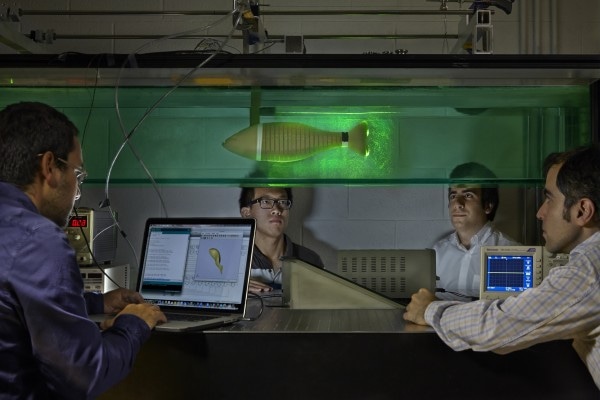Sep 16 2016
By observing how fish swim and use their fins to move seamlessly within the ocean depths, a researcher at Florida Atlantic University is mimicking this movement to increase maneuverability and enhance the motion of underwater vehicles and robotic systems. To advance this research area, Oscar M. Curet, Ph.D., an assistant professor in the Department of Ocean and Mechanical Engineering at Florida Atlantic University, in collaboration with Erik Engeberg, Ph.D., Manhar Dhanak, Ph.D., and Karl von Ellenrieder, Ph.D., also in FAU’s Department of Ocean and Mechanical Engineering, has received a $258,008 grant from the U.S. Department of the Navy, Office of Naval Research for state-of-the-art instrumentation that will enable 3D observation of underwater flow dynamics.
 Oscar M. Curet, Ph.D., in FAU's Department of Ocean and Mechanical Engineering (far right), has been observing how animals move to identify the differences between engineering systems and what occurs in nature. His team has a prototype under development, which was inspired by the Knife fish. (Credit: Florida Atlantic University)
Oscar M. Curet, Ph.D., in FAU's Department of Ocean and Mechanical Engineering (far right), has been observing how animals move to identify the differences between engineering systems and what occurs in nature. His team has a prototype under development, which was inspired by the Knife fish. (Credit: Florida Atlantic University)
The Volumetric Particle Image Velocimetry (PIV) System, which resembles a high-tech laser camera, will help researchers at FAU to measure and better understand how fluid dynamics interact with bio-inspired flexible propulsors in complex underwater environments. This system also will perform 2D PIV, stereo PIV, and micro-PIV synchronized with body kinematics. The research will promote and enhance interdisciplinary work at the intersection of engineering, robotics, biology, biomimetics and physical sciences.
“If we want to understand how to manipulate a propulsive system underwater, we need to understand its effect on the flow in the water,” said Curet. “The addition of this vital equipment in our laboratory will allow the precise measurement and analysis of complex 3D flow structures that until now have remained elusive.”
Measurements of three-dimensional or 3D flow is a crucial element in the progress of understanding the underlying physics of fluid dynamics of flexible propulsors.
Curet has been observing how animals move to identify the differences between engineering systems and what occurs in nature. He is adapting the suppleness of fins on fish and wings on birds to develop flexible structures that can respond the same way nature does — a departure from the more rigid materials and structures currently used for various engineering products.
“Birds can change the shape of their wings or change their morphology to adjust for wind conditions and fish can alter their fins in a quick manner to adjust their movement through turbulent waters,” said Curet. “They can adjust depending on the flow conditions of the air and water. We can’t yet do that with our products, that’s why it’s so critical for us to understand the interaction between flexible structures and their effects in propulsion, maneuverability and how they change directions. Everything interacts with flow in water or air. If you’re moving, you’re interacting with this flow.”
Curet and his team have a prototype that is currently under development (funded by the National Science Foundation), which was inspired by the Knife fish. This particular fish has the unique ability to effortlessly move forward, backward, vertically and horizontally. The prototype, composed of 3D printed materials, 16 motors, and a membrane, is being designed to be a completely submersible underwater vehicle that will be able to conduct a host of different tasks like surveillance, underwater floor surveys, and testing underwater structures. Curet plans to develop the prototype so that there can be a number of vehicles working in concert to co-interact with humans on tasks required for both commercial and military purposes in challenging underwater environments.
“We are very grateful to the Office of Naval Research for supporting the unique research that is being spearheaded by Dr. Curet at Florida Atlantic University,” said Javad Hashemi, Ph.D., professor and chair of the Department of Ocean and Mechanical Engineering in FAU’s College of Engineering and Computer Science. “Results from the series of projects that will be conducted using this important technology will yield fundamental knowledge on how flexible surfaces are able to interact and modify their wake structure to improve performance. Furthermore, this instrumentation will enhance student education and training by integrating the 3D-PIV system in select research-based classes.”
- FAU -
About FAU’s College of Engineering and Computer Science:
Florida Atlantic University's College of Engineering and Computer Science is committed to providing accessible and responsive programs of education and research recognized nationally for their high quality. Course offerings are presented on-campus, off-campus, and through distance learning in bioengineering, civil engineering, computer engineering, computer science, electrical engineering, environmental engineering, geomatics engineering, mechanical engineering and ocean engineering.